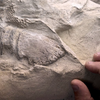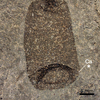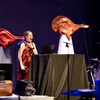Organic Glass Found Among Remains of Roman Guard

A sample of the vitrified brain of a Roman guard after the 79 CE eruption of Mt. Vesuvius
Post Author- Ellis Nolan
One of the most dramatic events in the history of the Roman Empire was the eruption of Mount Vesuvius in 79 CE. It is unknown how many perished during the eruption and its fallout, however, haunting images of contorted Pompeiians frozen in time by searing gas and ash paints an image of hellish, alien conditions. In a bizarre twist of the otherworldly occurrence, scientists have found the only documented instance of a victim whose brain was turned to glass by flows from the eruption.
The remains of the Roman guard and the Collegium Augustalium relative to Mt. Vesuvius
The victim in question was a male guard stationed at the Collegium Augustalium within the Roman city of Herculaneum. Upon imaging the glass found in the skull of the victim with a Scanning Electron Microscope (SEM), the scientists discovered multiple well-preserved neural structures, such as axons and neurons, visible in the sample. These discoveries helped them rule out other methods for the brain to have been preserved, since those structures would not be intact.
SEM images of the vitrified brain, the arrows in figure F point towards visible axons
For glass to form, a process called vitrification, a material has to be heated to an extremely high temperature, and then cooled, or quenched, extremely fast. In nature, this occurs somewhat often, such as when lightning strikes sand, forming fulgurites, or when magma cools, forming silicic glass. However, this is an extremely uncommon occurrence for material such as a human brain since organic tissue is mostly water. This means for it to be vitrified, it must be quenched below 0 degrees Celsius and stay at that temperature, lest the water return to its liquid state at room temperature.
This Roman guard appears to be a lone exception to the rule, even among the thousands of other human remains examined in Pompeii and Herculaneum. The researchers hypothesized that a stream of hot ash and gas, known as a pyroclastic flow, passed through the victim’s chambers at temperatures exceeding 500 degrees Celsius. This was followed by a much cooler (but still deadly to humans) and more widespread pyroclastic flow, which caused the rapid cooling of the subject.
This bizarre and unique occurrence is yet another example of the epic and otherworldly proportions of the eruption of 79 CE and the sheer power of natural disasters.
Interested in learning more about the Roman Empire? Check out our Rome collection here!
Featured Product
Joe Frazier Boxing Glove
Cool Things!

Is “Paul is Dead” Dead?: Unpacking One Of Pop Culture’s Most Enduring Conspiracy Theories

Scientists Discover Hooves and Skin in Preserved Dinosaur "Mummies!"
A dinosaur discovery just in time for Halloween! In a new analysis of a group of fossils from Wyoming, Scientists have determined this group of fossils are dinosaur “mummies,” with preserved skin and even hooves.

Scientists Record a Bat Catching Birds Mid-Flight!
Bats, birds, screeches, oh my! In a reverse-Hitchcock twist, a new study reveals that a species of European bat catches and eats birds mid-flight.
Specimen Deep Dives

The House that Ruth Built: The Story of the Old Yankee Stadium

The Queen of the Skies: the Story of the Boeing 747

Old Ironsides: The USS Constitution and the Start of the U.S. Navy
Long Form Articles

The Artist Behind the Macintosh: Susan Kare and Apple Computers
While the two Steves, Jobs and Wozniak, are the most well known faces behind Apple computers, equally important to the products and culture of the company were those who crafted the experience of using their computers through design. The most notable of these visual architects was Susan Kare, a designer responsible for “humanizing” Macintosh computers.

Can I Lick It? Yes You Can!
Have you ever been unable to tell if a fossil was really a fossil, but you were too embarrassed to admit it? Have you ever wanted to lick a fossil just because, but you didn’t want to risk judgment from your peers? Well, good news! You can kill two birds with one stone! Licking a fossil can actually help you determine if it’s the real deal or just another rock.

Is It Legal To Own a Meteorite: How to Start Your Outer Space Collection!
Meteorites are some of the rarest geological specimens to be found on Earth. Of course, since these stones are not of our world, purchasing them can sometimes be a confusing process. Is it legal to own a meteorite? In short, yes! Read on for help starting your cosmic collection!


















